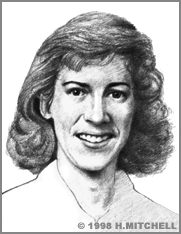Ellen Ochoa
Ellen Ochoa’s career offers an outstanding example of how invention can lead to adventure. She established herself as an innovative engineer and went on to become the world’s first Hispanic female astronaut.
Ochoa was born May 10, 1958 in Los Angeles, but she grew up in La Mesa, California. Throughout her youth, she devoted herself to music as well as math and science. When she graduated from San Diego State University in 1980 with a BS in Physics, Ochoa was considering a career either as a classical flutist or in business. But instead, mindful of her mother’s insistence on the importance of education, Ochoa chose to enter graduate school at Stanford University.
When Neil Armstrong had first walked on the moon (July 1969), Ochoa was 11 years old. It never would have occurred to her then that she too might someday become an astronaut. However, in 1983, when Ochoa was midway between earning her MS (1981) and PhD (1985) in Electrical Engineering, Sally Ride became the first female U.S. astronaut. This gave Ochoa the encouragement to aim high. Upon gaining her doctorate, she applied to NASA to become an astronaut herself.
At Stanford, Ochoa specialized in designing optical systems that analyze and draw conclusions about the objects that they “see.” After graduating, she continued this work at Sandia National Laboratory in Albuquerque, New Mexico. Sandia’s work for NASA includes developing optical, computerized recordings and models of events and phenomena in space. In time, Ochoa was granted patents as the co-inventor for three optical devices: a system that inspects objects, a system that identifies and can “recognize” objects, and a system that minimizes distortion in the images taken of an object. Later, working at NASA’s Ames Research Center in Mountain View, California, Ochoa branched off into developing computer systems designed for aeronautical expeditions. Here she supervised a staff of 35 fellow scientists.
Ochoa’s expertise in optics and computer hardware had caught NASA’s attention. The systems developed by Ochoa had the potential to improve not only the gathering of data, but also the assessing of the integrity and safety of equipment. In 1990, NASA accepted her into its astronaut training program, and in July 1991, Ochoa became an official U.S. astronaut.
Less than two years later, Ochoa flew as a Mission Specialist on a Discovery Space Shuttle Mission (STS-56, April 1993). The next year, she was Payload Commander on a follow-up Shuttle Mission (STS-66, November 1994). On the Shuttle expeditions, Ochoa conducted studies of the Sun’s effect on the Earth’s atmosphere and climate, deploying satellites like ATLAS-2 and ATLAS–3.
Ochoa has participated in an international study of damage to the Earth’s ozone layer and was in charge of U.S. Astronaut Office Support for the International Space Station project for two years.
Ochoa has logged nearly 1,000 hours in space, and on one of her missions, she became the first astronaut to play a musical instrument in space, playing the flute in low-Earth orbit.
She served as deputy director of NASA’s Lyndon B. Johnson Space Center from 2007 to 2013 and as director from 2013 to 2018. She became vice chair of the National Science Board in 2020.
Ellen Ochoa has won numerous awards for her success (including NASA’s highest honor, the Distinguished Service Medal) as an engineer, an astronaut, and a role model – not just for Hispanic or female aspiring scientists, but for anyone who believes that excellence will eventually find its recognition and reward.


